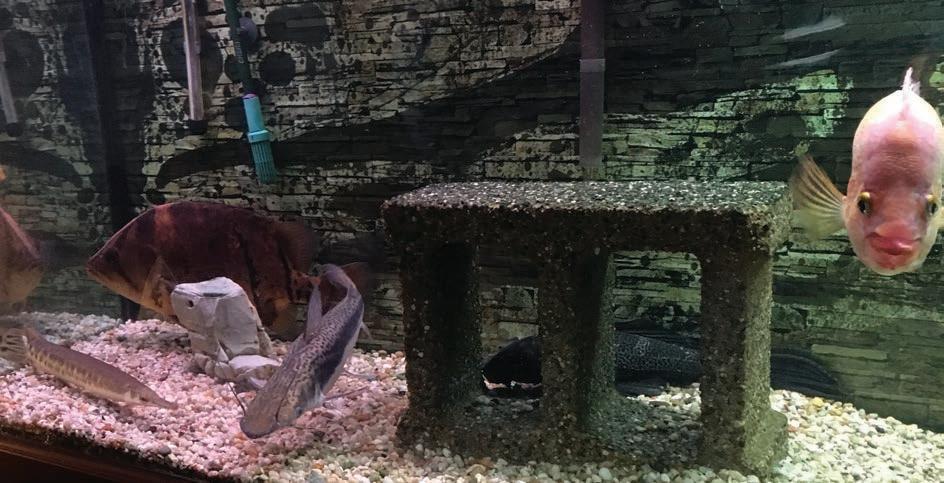
15 minute read
Keepers of the Wild
from Modern Aquarium
Why Do We Keep Fish?
by Abigail Weinberg
Little multi-colored fish flit around in plastic bags displayed on a table in the Queens Botanical Garden basement. Some of the fish were raised in New York. Others were from Central America by way of Kentucky. All were for sale at tonight’s fish auction, awaiting new homes in fish tanks across the city.
The fish swam in their bags while Rusty Wessel regaled about 60 tropical fish enthusiasts — mostly men, mostly graying — at the Greater City Aquarium Society’s monthly meeting. Wessel is a celebrity of sorts, having built a second house for his 8,000 gallons of fish in Kentucky. Tonight he had flown to New York with his fish in Kordon Breathable bags, in which they can live for weeks, to share his secrets about livebearers, fish who carry their eggs in their bodies and give birth to live offspring. Some of the fish on the table were livebearers he had scooped from the wild during one of his four yearly collection trips to Central and South Rusty Wessel America.
Wessel told the audience how they could determine a fish’s species by the shape of its dorsal fin, and about how overpopulation and overfishing have damaged South American fish populations. The group nodded, as if they understood a second language. When Wessel said that tilapia had been introduced to a pond of livebearers in Central America, the audience let out a collective groan, and someone yelled, “Oh, come on!” (Tilapia are often aggressive and can prey on smaller fishes like livebearers.)
For many fish keepers, like Wessel, what began as a hobby spiraled into a lifestyle. Data about the number of fish keepers is scarce, but the hobby dates to the 1850s, when the market for ornamental fish, tanks and books on the hobby began to flourish. Now hobbyists gather at local and regional meetings and conventions, competing for the rarest and most pristine specimens while attempting to preserve endangered species in the face of climate change and habitat destruction.
Fish are very different pets from cats or dogs or birds — and not just because they don’t make noise. They are, by nature, undomesticated, and part of their allure is that they are samples of nature. This desire to replicate nature within a fish tank often leads a hobby to become a full-blown obsession, says Judith Hamera, a professor of dance at Princeton and author of Parlor
Ponds: The Cultural Work of the American Home
Aquarium, 1850–1970.
“For some, the excess really comes from wanting to get as close to nature as possible,” Hamera said. “Part of it is the desire to bring this wilderness scape into the home as virtuosically as possibly, as naturalistically, as masterfully as possible.”
Joe Ferdenzi, Joseph Ferdenzi a formerly Queensbased fish keeper who now lives in Nassau County, says that he doesn’t even think of his fish as pets. “I thought of them as just part of this little miniature world I was creating,” he said. His miniature worlds now total more than 60 fish tanks in his basement.
Down in Kentucky, Wessel’s fish house takes imitation of nature to an extreme. He started keeping fish as a nature-obsessed pre-teen in Kentucky, and by the time he was 10 he had about a dozen aquaria. His father eventually built him a fish room in their basement, and the number of tanks multiplied to about 20 or 25.
Now, Wessel keeps about 100 aquaria in his fullyautomated fish house, separate from his own home. Wessel spent three years and $100,000 building the house by hand. The fish tanks include a mechanism to change the water automatically. The many windows provide natural light, and the temperature fluctuations in the house resemble those of Central and South American biotopes. All Wessel needs to do is feed the fish once a day and clean the filters and glass periodically.
“I wanted it to basically mimic what the fish do in nature,” Wessel said. “People tell me all the time, ‘This is the best fish room ever.’ I don’t know that it is, but I know it works for me.”
Most of the New York-based attendees at Wessel’s presentation don’t have the luxury of building separate houses for their fish, so they improvise, cramming fish tanks into the nooks and crannies of their apartments. Dan Radebaugh, Editor of the GCAS periodical, Modern Aquarium, keeps about 10 tanks and 800 gallons of water and fish in his Jackson Heights apartment: one in the living room, one in the dining room, two in the hallway and six in the office, plus a one-gallon tank containing a Betta fish.

Even in an apartment it’s not hard for one tank to lead to another, and another. Radebaugh’s wife Marsha explained the evolution, saying, “You get different fish that are not compatible. Or you breed them and you get another tank to grow out the fry (offspring). “You have a community tank and a specialized tank.”


Dan and Marsha Radebaugh
While “My tai chi teacher might call it ‘greed,’” Radebaugh said, the fish community might more likely call it MTS: multiple tank syndrome.
Most of Radebaugh’s tanks contain three or four big fish, with pebbles for the fish to rearrange or not, white artificial lighting, rocks and driftwood, bubbling filters, and scenic paper backdrops taped to the backs of the tanks. There are catfish and Oscars and garfish, and a red bay snook. There are gouramis and discus. In another tank, rainbowfish and little plecos and shrimp. In another, a kuhli loach. In another, gold severums poke at green pebbles. Above them, African leaf fish and three silver dollars. Oh, and the plants: Java fern and Java moss and hair algae. Ask Radebaugh the fishes’ Latin names, and he’ll tell you.
This all may seem prohibitively time-consuming and costly, but hobbyists say it’s worth it. Radebaugh said that his fish, mostly cichlids, tend to live long enough that the cost of collecting them is not overwhelming. He has had his favorite fish, a datnoid, for 14 years, having raised it from the size of a quarter to that of a dinner plate. And the prices of individual fish vary greatly, from a few dollars for common fish — bettas, some goldfish, some killifish — to hundreds of dollars for rarer species.
For all his efforts, Wessel, who works in the family real estate and insurance business but has a degree in marine biology, spends only about 30 minutes a day interacting with the fish. Ferdenzi averages about an hour per day in the fish room. Radebaugh performs 80 percent water changes twice a week, which takes about an hour and a half to two hours and involves siphoning water from a fish tank to the drain with a hose. (New York water is great for fish, he said.) Even when he was working in the medical publishing business, he says that it wasn’t hard to find the time to take care of the fish.
“It’s not something that I look upon as a chore,” he said. “It’s just part of the deal. You gotta keep ‘em healthy.”
Besides, they’re friends with whom he shares an emotional bond. Fish keepers are often of the mind that fish are smarter than most people give them credit for. Radebaugh said that his fish are aware of his movements throughout the apartment. He once separated a mating pair of cichlids using a divider with a small hole so the female could escape if the male became aggressive — standard practice among cichlid breeders. Each time Radebaugh left the room, the male nevertheless somehow escaped to the female’s side of the divider. No matter how many times Radebaugh replaced the male, he always sneaked to the other side when Radebaugh left the room. Radebaugh eventually had to set up a series of mirrors to find out how the fish was escaping. The fish knew that he was misbehaving. “He didn’t want us to know how he was doing it,” Radebaugh said.
Radebaugh thinks that this form of humananimal relationship may be one of the reasons why the hobby is so male-dominated. “Perhaps it could be a socially O.K. way for men to be nurturing and still keep enough masculine stuff, like going out
animal relationship may be one of the reasons why the hobby is so male-dominated. “Perhaps it could be a socially O.K. way for men to be nurturing and still keep enough masculine stuff, like going out and catching the damn things and working with the and catching the damn things and working with the equipment,” he said. equipment,” he said. Hamera thinks the reason the hobby is mostly men is that it began in a time when men were more likely to be able to travel to Judith Hamera Hamera thinks the reason the hobby is mostly men is that it began in a time when men were more likely to be able to travel faraway lands than women. to faraway lands than Another factor, she said, is were women. Another that men often deliberately factor, she said, is that exclude women in order to men often deliberately preserve their “culture of exclude women in order to male geekdom.” “There’s preserve their “culture of this sense of men using this male geekdom.” “There’s this sense of men using this historically to carve out historically to carve out a space free from domestic a space free from domestic responsibilities — that responsibilities — that is, from the home — and is, from the home — and creating a male space of creating a male space of leisure and comfort that sexists leisure and comfort that sexists would believe might would believe might be jeopardized by inclusion,” she be jeopardized by inclusion,” she said.
Whatever the causes, the boys’ club mentality Whatever the causes, the boys’ club mentality is is so prevalent in the fish hobby that the American so prevalent among the fish hobby that the American Cichlid Association has a women’s division called Cichlid Association has a women’s division called Babes in the Cichlid Hobby — BitCHes, for short.Babes in the Cichlid Hobby — BitCHes, for short.
Not only is the hobby mostly male; it is also Not only is the hobby mostly male; it is also highly competitive, with collectors vying for the most highly competitive, with collectors vying for the most exquisite specimens. “One of the drivers behind excess is competition,” Hamera said. “Can you get Modern Aquarium - Greater City A.S (NY) a rare species? Can you get a more rare species than someone else? Can you have a larger setup?” This competition manifests in several ways. There are national fish conventions in which keepers from across the country bring their rare fish to swim before judges. The fish community is not as organized as, say, the National Audubon Society. It is instead divided into a series of clubs based on region and type of fish. There are various organizations, both regional (such as The Northeast Council of Aquarium Societies — one of the organizational councils under which many local clubs, including GCAS, operate) — hold yearly meetings that feature expert speakers, bowl shows, breeder awards, club publication awards, auctions, and so forth. There are also organizations devoted to certain types of fish. The American Cichlid Association holds a yearly cichlid competition where entries are divided into four classes: North and Central America; South America; African Rift Like and African NonRift Lake, Madagascar and Asia. There are fish tanks available at the venue, and competitors haul their fish to the show in the backs of their cars. “The number one question I’m always asked when I tell people about the fish shows is, ‘Really, how do you bring fish to the show?’” Ferdenzi said. “Ever hear of bags and buckets?” It’s a lot easier for fish to survive in bags and buckets than you’d think. Wessel said that the earliest means of transporting fish was via metal buckets. Now, breathable plastic bags allow carbon dioxide to escape and oxygen to enter the water, so fish don’t suffocate. Fish that are flown in from overseas can survive in breathable bags inside Styrofoam containers. For a few hours en route to a fish show, fish do just fine in the old-fashioned plastic buckets that can be bought at Home Depot.
Wessel, who has judged at the Northeast Council fish show, said that the fish are graded based on color, size, condition, finnage and deportment. Each category is worth 20 points, and the total score is calculated out of 100. The fish should be brightly colored, fully grown, intact (no missing scales or damaged fins) and lively — they should react if you put your finger against the glass.
And that’s just for cichlids. There’s the American Killifish Association for collectors of those small, brightly colored fish. There are also the “fraggers,” who collect coral. And oddly enough, landlocked Ohio is to fish keepers what L.A. is to actors. The state is home to a vibrant community of fish clubs, from the Greater Akron Aquarium Society to the Columbus Area Fish Enthusiasts to the Ohio Cichlid Association. A yearly show, the Ohio Cichlid Extravaganza is one of the biggest in the community, allowing for more than 150 entries and garnering visitors who make the trek from the east coast.


Above: Scene from an NEC convention a couple of years ago. Below: Some of the children at the convention holding their own meeting. Photos by Jules Birnbaum
The competition exists at the micro level too. The GCAS meetings, as well as many other small-scale fish clubs, feature bowl shows in which a judge rules
on the quality of fish that members have brought in bags. Radebaugh generally doesn’t compete, though. “I have a few times, but with the larger fish it’s an awful lot of trouble to pack those guys up and move them, and there’s always a chance that something will go wrong.”
Fish shows, according to Ferdenzi, are “becoming sort of an anachronism” — they’re not worth the work it takes to organize them. For Ferdenzi, who served as the president of GCAS for 19 years and who has an almost encyclopedic knowledge of the history of the fish hobby in New York, the allure of competing wore off over time. “My fish room is festooned with trophies and plaques that I won at those events,” he said. “After a while there’s only so many plaques and awards. You just say to yourself, ‘Been there, done that many times.’”
Even fish clubs, the bread and butter of organized fish keeping, are taking a hit in the internet era. Roughly 70 to 90 people attend GCAS’s monthly meetings, and another 90 to 100 people attend the Brooklyn Aquarium Society’s monthly meetings at the New York Aquarium in Coney Island, but these are the last two remaining general fish clubs of what was once a vibrant fish scene in the city.
Ferdenzi said that the aquarium hobby was so popular in the 1930s that thousands of people came to see a neon tetra (today a common fish) displayed at a GCAS show. “It was such a novelty that a story about it ran in the New York Times,” he said with a laugh.
But today’s fish hobbyists have one thing that yesterday’s hobbyists lacked: an intimate understanding of the environmental factors that threaten many aquarium fish (and others) with extinction in the wild.
Many who took up the hobby as a leisure activity have become unexpected environmentalists. Wessel, for example, has seen firsthand the effects of climate change on fish communities.
“When I first started going (to Central America), when you put a net in the water, you came up with a lot of fish. There were so many fish, and not so many people. Today when you go there, there are so many people, but so few fish,” he said. He attributes the declining fish populations to pollution, overfishing and destruction of habitats. What’s more, he said, with weather extremes, the water in these regions has become completely unpredictable: now it may pour during the height of the dry season.
As fish species’ native habitats are threatened, fish keeping is one way to ensure that the species survive. In 2004 Claudia Dickinson, a GCAS member, founded a program that encourages fish keepers to keep atrisk species, “offering that species a future of hope.” The program, CARES — Conservation, Awareness, Recognition and Responsibility, Encouragement and Education, and Support and Sharing — unites amateur fish keepers with professional ichthyologists (fish zoologists) to determine which species are most at risk.
Ferdenzi, a CARES member, tries to keep fish that are endangered in the wild. “I have a cichlid from a crater lake in West Africa, and this is the only place in the entire world where this fish is found,” he said. “If something were to happen to that biotope, the species would be extinct in the wild.”
Hamera believes that fish keepers will begin to see themselves as saviors of dying species. “I think one of the things you can expect to see is the aquarium functioning as a kind of new utopia, as kind of a time capsule so that captive fish-breeding and coral fragging become like little arks — little lifeboats for species,” she said.
Radebaugh keeps a tank of highly endangered Mexican livebearers that he shares with other fish keepers, but he doesn’t see keeping endangered fish as pets as the long-term solution. “What we need to do long-term is to be sure that they can survive in some kind of natural way,” he said. “The more we can do to keep the earth and the water able to sustain varied life, the better our lives will also be.”
Wessel advocates for re-introducing endangered species back into the natural habitats — a process that has already occurred in some areas, such as Lake Malawi.
“Number one is to preserve them, to get them established by aquarists or farms or aquariums,” he said. “But the number two, long-range goal, of course, is for them to be re-introduced at some point.”
Sources: Parlor Ponds: The Cultural Work of of the American Home Aquarium, 1850 - 1970, by Judith Hamera Published by University of Michigan Press. (2012)
Rusty Wessel rusty@wesselinsurance.com Dan Radebaugh gcas@earthlink.net Judith Hamera jh41@princeton.edu Joseph Ferdenzi gfcadeo@gmail.com
https://caresforfish.org/?page_id=704 https://northeastcouncil.org/ https://caresforfish.org/?page_id=36 https://www.ohiocichlid.com/extravaganza
Photos of Dan & Marsha Radebaugh and Joseph Ferdenzi by Joseph Gurrado.
Editor's Note: Abigail is a daughter of Judith Weinberg, who spoke at one of our GCAS meetings a few years back. This article was originally written as a journalism project.




